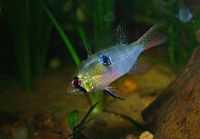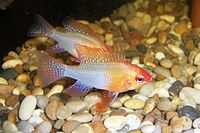Ram cichlid
| Ram cichlid | |
|---|---|
 | |
| Pair of captive-bred Microgeophagus ramirezi chasing a couple of dwarf Synodontis from their nesting site. The male is in the foreground and can be recognised by his brighter colours and longer fin rays (especially in the dorsal). | |
| Scientific classification | |
| Kingdom: | Animalia |
| Phylum: | Chordata |
| Class: | Actinopterygii |
| Order: | Perciformes |
| Family: | Cichlidae |
| Subfamily: | Geophaginae |
| Genus: | Mikrogeophagus |
| Species: | M. ramirezi |
| Binomial name | |
| Mikrogeophagus ramirezi (G. S. Myers & Harry, 1948)[1] | |
| Synonyms | |
| |
Mikrogeophagus ramirezi is a species of freshwater fish endemic to the Orinoco River basin, in the savannahs of Venezuela and Colombia in South America.[2] The species has been examined in studies on fish behaviour[3] and is a popular aquarium fish, traded under a variety of common names including Ram, Blue ram, German blue ram, Asian ram, Butterfly cichlid, Ramirez's dwarf cichlid, Dwarf butterfly cichlid and Ramirezi.[2][4][5][6][7] The species is a member of the family Cichlidae and is included in subfamily Geophaginae.[2][8]
Appearance and sexual dimorphism

They are naturally soft water set of fish. Wild ram cichlids are often more colorful than the tank bred counterparts, which suffer from poor breeding and also being injected with hormones for more color, although this makes as many as one in four males infertile. Male specimens of the ram usually have the first few rays of the dorsal fin extended, but breeding has made some females also show this. There is also the fact that, when close to spawning, female rams have a pink or red blush on the abdomen. Females also have a blue sheen over the spot just below the dorsal fin, and males do not show this. Males reach a maximum length of seven centimeters, and females are usually slightly smaller. (Please note that the black spot method of sexing does not apply for the golden and electric blue varieties of the species.)
Distribution and habitat
The natural habitat of M. ramirezi occurs in the warm, (25.5-29.5 °C, 78-85 °F), acidic (pH 5) water courses in the llanos savannahs of Venezuela and Colombia.[4][6][9] The water at sites where M. ramirezi has been found is generally slow-flowing, contains few dissolved minerals, and ranges in colour from clear to darkly stained with tannins.[4] The species is typically found where cover in the form of aquatic or submersed vegetation is available.[4]
Reproduction




Taxonomy, collection and etymology
The ram cichlid is named after Manuel Ramirez, an early collector and importer of the species for the aquarium trade.[11] George S. Myers and R. R. Harry (1948) originally described the species as Apistogramma ramirezi though the species was later moved to and from various genera including: Microgeophagus, Papiliochromis, Pseudoapistogramma and Pseudogeophagus.[12]
In the aquarium

The ram cichlid is a popular cichlid for the tropical freshwater, community aquarium although it is not necessarily the easiest cichlid to maintain in many situations.[4] This is because the species is often kept with other fish that are more assertive, aggressive or overly active.[4][6] The species is innately shy and is best kept with passive dither fish, such as neon or cardinal tetras.[6] The species will readily exhibit breeding behaviours in water of pH 5.0-6.5, though softer water encourages more regular spawning.[4][6][9] It is easier to maintain the species in larger aquaria as the species is intolerant of common aquarium pollutants such as nitrate.[6] The aquarium should be decorated to mimic the natural environment and is best decorated with several densely planted regions of aquatic plants, separated by open water.[5] The species is prone to filial cannibalism of its brood if distressed.[6] As the water must be free of pollutants, aquarium filtration is important, though water movement should not be extreme. Removing and replacing small amounts of water assists with minimizing the quantities of these pollutants and should be conducted regularly.[9]
Numerous strains of M. ramirezi have been developed in Asia for the fishkeeping hobby. These include numerous xanthistic forms, known as gold rams, along with larger, high-bodied and long-finned varieties.[4][6][13] Many of these varieties suffer from lower fertility, health problems or reduced brood care in comparison to wild-type specimens.[4][5]
See also
| Wikimedia Commons has media related to Mikrogeophagus ramirezi. |
References
- ↑ Myers GS, Harry RR (1948) The Ramirezi dwarf cichlid identified. Aquarium, Philad. 77.
- ↑ 2.0 2.1 2.2 Froese, R. and D. Pauly. Editors. "Mikrogeophagus ramirezi, Ram cichlid". FishBase. Retrieved 2007-04-09.
- ↑ Robins CR, Bailey RM, Bond CE, Brooker JR, Lachner EA, Lea RN, Scott WB (1991) World fishes important to North Americans. Exclusive of species from the continental waters of the United States and Canada. Am. Fish. Soc. Spec. Publ. 21: p. 243.
- ↑ 4.0 4.1 4.2 4.3 4.4 4.5 4.6 4.7 4.8 4.9 4.10 4.11 4.12 Linke H, Staeck L (1994) American cichlids I: Dwarf Cichlids. A handbook for their identification, care and breeding. Tetra Press. Germany. ISBN 1-56465-168-1
- ↑ 5.0 5.1 5.2 5.3 Riehl, Rüdiger. Editor.; Baensch, HA (1996. 5th Edn.). Aquarium Atlas. Germany: Tetra Press. ISBN 3-88244-050-3.
- ↑ 6.0 6.1 6.2 6.3 6.4 6.5 6.6 6.7 6.8 6.9 6.10 Loiselle, Paul V. (1995). The Cichlid Aquarium. Germany: Tetra Press. ISBN 1-56465-146-0.
- ↑ Axelrod HR, Vorderwinkler W (1995) Encyclopedia of tropical fishes 30th Edn. TFH Publications, USA.
- ↑ ITIS Report. "Mikrogeophagus ramirezi, Ram cichlid". Integrated Taxonomic Information Service. Retrieved 2007-04-09.
- ↑ 9.0 9.1 9.2 9.3 9.4 Richter H-J (1989) Complete book of dwarf cichlids. Tropical Fish Hobbyist, USA
- ↑ Coleman RM, Galvani AP (1998) Egg Size Determines Offspring Size in Neotropical Cichlid Fishes (Teleostei: Cichlidae) Copeia 1:209-213.
- ↑ Leibel WS (1993) A fishkeepers guide to South American Cichlids. Tetra Press. Belgium. 55-56.
- ↑ Robins CR, Bailey RM (1982) The Status of the Generic Names Microgeophagus, Pseudoapistogramma, Pseudogeophagus and Papiliochromis (Pisces: Cichlidae) Copeia 1: 208-210.
- ↑ Amazon Rift Aquarium. "Long finned rams". Retrieved 2007-04-09.